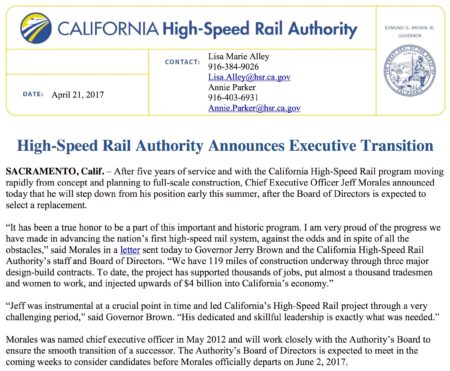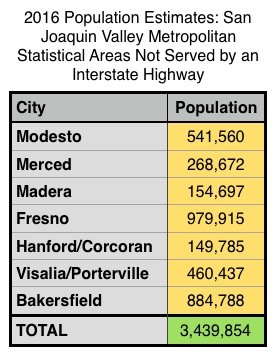Applying for New CEO of the California High-Speed Rail Authority: My Cover Letter
Editor’s Note: Kevin Dayton asked if he could leave the California Policy Center to apply for an opening at the California High-Speed Rail Authority. We told him to give it a shot…
Re: Application for CEO of California High-Speed Rail Authority
Dear Sir or Madam:
 I am interested in becoming the Chief Executive Officer (CEO) of the California High-Speed Rail Authority.
I am interested in becoming the Chief Executive Officer (CEO) of the California High-Speed Rail Authority.
I ruminated in my April 11, 2017 California Policy Center commentary “Is the California High-Speed Rail Authority Paying for Legendary Leadership?” about the potential for a CEO who “freed himself from political demands and could independently develop and implement a strategy for the proposed system.” Just ten days later, the Authority announced that the current CEO would step down on June 2, 2017.
Below are my ideas on how I would serve the People of California as CEO.
Salary Requirement Is Commiserate with the Sacrifice of Public Service
This position is special. It is serving The People by overseeing a project intended to evolve and endure for generations as a symbol of human progress and achievement. The inspiration for serving in this role needs to transcend personal monetary compensation. Therefore, I’m willing to accept $191,742, half of the $383,484 income that current CEO Jeff Morales is reportedly earning.
Purpose and Role of the CEO: To Serve The People
The California High-Speed Rail Authority would benefit from honesty. Why not be blunt and forthcoming with the California legislature, the U.S. Congress, the Trump Administration, and most importantly, The People about the logistical challenges and financial struggles of this project? The Authority management often seems to operate as if obfuscation and propaganda will allow it to progress.
In the end, this strategy will fail. People who pay attention aren’t fooled. However, the project is not doomed to failure. Californians are often willing to offer second chances, as long as failure is acknowledged and there is a plan to set things right.
The CEO needs to be an advocate for the public instead of a serving as an insider liaison for the construction industry or as a loyalist to politicians. Why do so many Californians regard California High-Speed Rail as a political payoff or a selfish legacy project for one specific politician? It shows fundamental flaws in how the Authority justifies and portrays the project to the people and their elected representatives.
The CEO must think every day about the perspective of the people who are paying for the system and who will presumably ride the system when it is completed. California High-Speed Rail could become an infrastructure priority supported by most Californians – if the Authority is seen as an ally rather than an exploiter.
Establish a Focused Vision and Purpose and Abandon the Utopian Schemes
California High-Speed Rail should p rovide state residents and visitors with a reasonably fast and reliable mode of transportation, at a competitive price, as an alternative to driving or flying. The Authority needs to focus on fast transportation and abandon all of the parasitical special interests making demands on the system. Distractions that need to be purged include downtown urban renewal, social justice, job creation, and stopping climate change. Build the system as fast transportation between cities and stop seeing it as a way to change the world.
rovide state residents and visitors with a reasonably fast and reliable mode of transportation, at a competitive price, as an alternative to driving or flying. The Authority needs to focus on fast transportation and abandon all of the parasitical special interests making demands on the system. Distractions that need to be purged include downtown urban renewal, social justice, job creation, and stopping climate change. Build the system as fast transportation between cities and stop seeing it as a way to change the world.
Accountability to The People
The Authority is not, will not, and cannot achieve the numerous criteria set in law via Proposition 1A, the $9.95 billion bond measure approved by 52.7% of California voters in November 2008. The ballot measure and the arguments submitted in support of it misled a lot of voters. A new ballot measure needs to be presented to voters to revise or eliminate the unrealistic constraints and false promises established in the original bond measure.
In fact, the Authority (through the legislature) should offer a comprehensive statutory overhaul of the program in addition to the authorization of new funding sources. Much has changed in ten years. It would be proper, appropriate, and respectful to the voters to offer a new ballot measure and ask them to approve it.
In the meantime, California High-Speed Rail will be the most ambitious and expensive infrastructure project in human history. That makes it a target for corruption in contracting and employment. The public needs to be continually reassured, with data, that their money is being spent properly. Failures, problems, and changes need to be announced openly by the Authority with adequate explanation.
Either through a ballot measure or through statute, the Authority must be prohibited from doing two things: (1) awarding discounted tickets to individual passengers or categories of passengers who identify with various favored constituencies; and (2) naming the system or any asset or facility after any individual – living or dead – or organization or corporation.
A major challenge for the Authority is obtaining property from Californians who have strong multi-generational ties to the land from which they earn a living. Although many backers of California High-Speed Rail think private citizens should surrender their interests for the public good, a significant portion of Californians still respect property rights and are uncomfortable about government land takings. The Authority needs to be open and transparent to the public about the specific land parcels it wants to obtain and the reasons it wants to obtain those parcels. It needs to bargain in good faith and assure the public it is doing so.
Be Realistic and Respectful with the Design and Alignment of the System
The Initial Operating Segment should serve the Central Valley and extend from Roseville to the outskirts of Bakersfield. The engineering and cost challenges of building the system through the Pacheco Pass and the Tehachapi Mountains are too significant to be overcome at this time. And presumably this would ease traffic on Highway 99.
Rather than trying to build the system through the urban downtown cores of various cities, the Authority should try to connect large parking lots on the edge of cities for the convenience of suburban residents who realistically aren’t going to bike or take the bus to their business meetings. It’s time for the Authority to detach itself from the urban planners and their schemes to manipulate personal mobility in pursuit of a utopian vision. Not everyone wants to live in a micro-unit above an independent coffee shop in a transit village without parking.
As much as possible, the train alignment should be adjacent to existing interstate highways, in particular I-5. A high-speed rail train whipping past a car on Interstate 5 south of Tracy is more effective advertising than any TV commercial could ever hope to achieve. In addition, placing the alignment close to I-5 will eliminate many of the disputes with property owners and communities who resent what they perceive as coastal intellectuals trying to transform their rural agricultural culture.
Transform the Image from Dowdy Government Agency to Exciting Vision
The Governor and the California Legislature needs to overhaul the makeup and activities of the Authority board. This board desperately needs energy, passion, and excitement. This is one case in which it would be appropriate and advantageous to pack the board with famous public figures, even in sports and entertainment, to be the face of leadership for California’s future. And the Board also needs skeptics and critical thinkers to serve as a pivotal check and balance for the agency.
Recruit Private Investors and Give Taxpayers Some Relief
With the assistance of the Authority, the current and future Governors of California need to prioritize a campaign to identify and recruit private investors or parties to get involved in construction and operation of the system. When traveling the world to attend international conferences, the Governor should be promoting private investment in the state’s high-speed passenger train. In fact, this should be the Governor’s top priority when traveling out of state. The People of California expect and demand it. The Authority should also expect and demand it.
The Authority should also initiate an aggressive campaign to convince public and private pension plans to invest money in California High-Speed Rail. The lack of investment reveals more about the outlook for this system than any press release from the Authority’s communications department. Surely the construction trade unions that enjoy the favoritism of a Project Labor Agreement on this project should consider an investment by their fringe benefit trust funds.
Be Careful of Strings Attached
Federal funding to build the system will always come with conditions, and some of those conditions will be inserted through the interference of politicians. If the Authority is to be bound by inflexible terms and conditions in order to receive federal funds, then the Authority needs to make the difficult and courageous decision to decline the funds. They also needs to politely but publicly ask the politicians to refrain from ornamental provisions so that the Authority has the flexibility needed to complete the project.
Anticipating Things That Could Change or Go Wrong
The Authority needs to consider the strategic value of publicly indicating a plan for train system infrastructure if lack of financing or logistical obstacles hinder continued advancement of the program. Californians may be more willing to support the system if it is built incrementally with a deliberate plan to use each component for other purposes to benefit the public. Why not announce that the Initial Construction Segment from Madera to Shafter will serve as a dedicated Amtrak line until other segments are completed? Why not announce that the Madera to Fresno segment will serve as commuter rail until other segments are completed?
 With the recent passage of transportation tax and fee increases (Senate Bill 1) comes a commitment from the state to provide $400 million for service expansion of the Altamont Corridor Express to Stanislaus and Merced counties. What is developing is a potential 125-150 mph Amtrak California operation in the Central Valley to serve several San Joaquin Valley cities (Modesto, Merced, Fresno, Visalia, Bakersfield) that lack an interstate highway and easy access to a major airport. Would the public accept a truncated fast-rail project that does not connect the San Francisco Bay Area with Southern California?
With the recent passage of transportation tax and fee increases (Senate Bill 1) comes a commitment from the state to provide $400 million for service expansion of the Altamont Corridor Express to Stanislaus and Merced counties. What is developing is a potential 125-150 mph Amtrak California operation in the Central Valley to serve several San Joaquin Valley cities (Modesto, Merced, Fresno, Visalia, Bakersfield) that lack an interstate highway and easy access to a major airport. Would the public accept a truncated fast-rail project that does not connect the San Francisco Bay Area with Southern California?
Time for a Change
In conclusion, the Authority needs to adjust to new and impending circumstances. President Obama is out of office and Governor Brown is approaching his last 18 months in office. The business cycle will turn again and the economy will slow or go into recession, with the resulting shortfalls in tax revenue that have vexed the State of California in the past. Without a dramatic change in direction, the California High-Speed Rail program will come to an ignominious end.
That legacy doesn’t benefit anyone. My ideas for serving as the CEO of the California High-Speed Rail Authority veer in a different direction from what has been seen for the past eight years. Please consider meeting me for an interview and an opportunity to elaborate on these ideas.
Sincerely,
- Citizens for California High-Speed Rail Accountability (CCHSRA)
- Howard Jarvis Taxpayers Association
- Californians Advocating Responsible Rail Design (CARRD)
- California Policy Center
Kevin Dayton, a frequent contributor to CPC’s Prosperity Digest, is the President & CEO of Labor Issues Solutions, LLC, and is the author of frequent postings about generally unreported California state and local policy issues at www.laborissuessolutions.com. Follow him on Twitter at @DaytonPubPolicy.
